

Chemistry and the Aquarium. Last month I reported on the purity of several brands of calcium chloride, including the relatively inexpensive Dowflake 77-80% Calcium Chloride available at Home Depot for about $12 for 50 pounds.
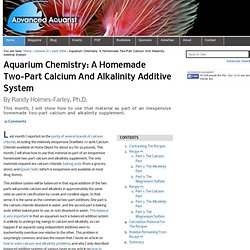
This month, I will show how to use that material as part of an inexpensive homemade two-part calcium and alkalinity supplement. The only materials required are calcium chloride, baking soda (from a grocery store), and Epsom Salts (which is inexpensive and available at most drug stores). Reef Aquarium Water Parameters by Randy Holmes-Farley - Reefkeeping.com.
Aquarists often ask what water parameter levels make for a successful reef aquarium.
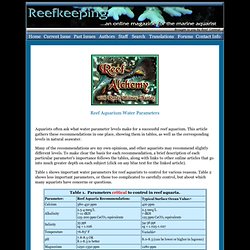
This article gathers these recommendations in one place, showing them in tables, as well as the corresponding levels in natural seawater. Many of the recommendations are my own opinions, and other aquarists may recommend slightly different levels. Mantis shrimp. Called "sea locusts" by ancient Assyrians, "prawn killers" in Australia and now sometimes referred to as "thumb splitters" – because of the animal's ability to inflict painful gashes if handled incautiously[4] – mantis shrimp sport powerful claws that they use to attack and kill prey by spearing, stunning, or dismemberment.

Although it only happens rarely, some larger species of mantis shrimp are capable of breaking through aquarium glass with a single strike from this weapon.[5] Ecology[edit] These aggressive and typically solitary sea creatures spend most of their time hiding in rock formations or burrowing intricate passageways in the sea bed. They either wait for prey to chance upon them or, unlike most crustaceans, at times they hunt, chase, and kill prey. They rarely exit their homes except to feed and relocate, and can be diurnal, nocturnal, or crepuscular, depending on the species. Tetraodon biocellatus. Tetraodon biocellatus, commonly the figure 8 puffer or eyespot puffer, is a pufferfish found in freshwater in Southeast Asia.
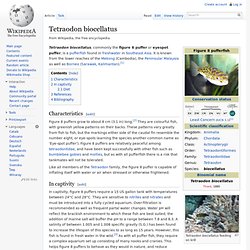
It is known from the lower reaches of the Mekong (Cambodia), the Peninsular Malaysia as well as Borneo (Sarawak, Kalimantan).[1] Characteristics[edit] Figure 8 puffers grow to about 8 cm (3.1 in) long.[2] They are colourful fish, with greenish yellow patterns on their backs. These patterns vary greatly from fish to fish, but the markings either side of the caudal fin resemble the number eight, or eye-spots (earning the species another common name as 'Eye-spot puffer').
NA Cichlids. Powder Blue Jack Dempsey Cichlid. Powder Blue Jack Dempsey Cichlid Nandopis octofasciatus or Nandopsis octofasciatum var. 'Electric Blue' a.k.a.
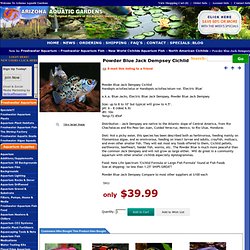
Jack Dempsey (fish) The Jack Dempsey (Rocio octofasciata) is a species of cichlid that is widely distributed across North and Central America (from Mexico south to Honduras).[1][2][3] Its common name refers to its aggressive nature and strong facial features, likened to that of the famous 1920s boxer Jack Dempsey.[4] The fish is native to Mexico and Honduras,[1] where it is found in slow-moving waters, such as swampy areas with warm, murky water, weedy, mud- and sand-bottomed canals, drainage ditches, and rivers.[2] It is also established as an introduced species in Australia, the USA and Thailand (presumably as an aquarium escapee) These are locally know as the Mexican Blue Frontosa.[5] The Jack Dempsey natively lives in a tropical climate and prefers water with a pH of 6-7, a water hardness of 9–20 dGH, and a temperature range of 22–30 °C (72–86 °F).

It can reach up to 25 cm (10 in) in length. Jack dempsey fish. Blue Acara Cichlid. Blue Acara CichlidBlue Acara Aequidens pulcher The Blue Acara is another beautifully marked cichlid that is very popular with South American Community Tank hobbyists.

Its body is mottled brown with many electric blue colored spots throughout and also form gorgeous lines on the mouth. The males of this species have longer pointed dorsal and anal fins like many South American species of cichlid, and the fins are also outlined in red. These are an easy to breed fish that do great in a community aquarium with other fish of similar size as well as most skirt tetras. Blue Acaras prefer a tank with a sandy bottom or smaller pebbled substrate with lots of rocks and plenty of hiding places created with many pieces of driftwood.
The Blue Acara is generally peaceful with other fish of similar size, but can get territorial during breeding time, but most fish are. New World Cichlids and Plants? [Archive] - Aquaria Central. View Full Version : New World Cichlids and Plants?
![New World Cichlids and Plants? [Archive] - Aquaria Central](http://cdn.pearltrees.com/s/pic/th/cichlids-archive-aquaria-61031896)
Water_wako I was wondering if I am to keep any plants with New World cichlids? I was planning to have them in terra cotta pots and attach plants to rocks and wood to prevent uprooting from digging habits. I hoping to keep a Geophagus and maybe a serverum or a festum. I think the Severum is herbivorous. Excuzzzeme LOL that's a tough one.
SA & CA Cichlids. Blood Parrot Cichlid. Black Convict Cichlid. Geophagus balzanili. New World Cichlid Geophagus balzanii Gymnogeophagus balzanii Size: up to 10" in the Wild, Our's are captive bred and tend to only get to 6" pH:6.2 - 7.5 (ideal 7.0) dH: 8-13 Temp:78-82F Origin: Streams and backwaters of Paraguay, South America Another amazing "Earth Eater" Cichlid, similar to the Jurupari.
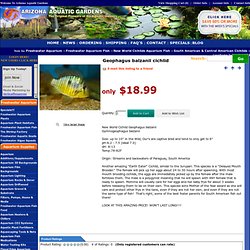
Plants 101 - Plants and African Cichlids. I had to learn these tricks the hard way – by trial and error (mostly error).
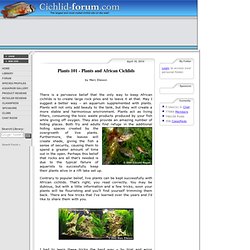
When I first began keeping cichlids, I tried my hand at aquatic horticulture (on a very small scale), but quickly gave up any hope of ever keeping plants with my cichlids. It would be another three years before I would try again. Photographs of Dutch-style aquariums rekindled my interest and now I was ready to give it a more devoted effort. It’s important to appreciate that not all African cichlids are the same, and not all plants are the same either. Before attempting to plant your tank, you need to educate yourself with the possibilities. The first tip is to consider lighting. Algae outbreaks are another discouraging problem often experienced in planted rift lake aquariums.
Third, it is important to know what plants will thrive with your mix of cichlids. The fourth item in need of consideration is how to plant your plants. Again, specifics will be covered in greater detail in Plants 102. Salvini Cichlid. Salvini Cichlid Salvini Cichlid cichlasoma salvinia.k.a. Bright Salvini Cichlid It lives best in a temperature between 72oF and 79oF, and at a pH ranging from 6.5 to 8.0. Firemouth Meeki Cichlid. Community Tank. Dwarf Bolivian Ram Cichlid. Dwarf Bolivian Ram Cichlid Microgeophagus altispinosa a.k.a. Butterfly Ram, Red Ram Size: up to 3" pH: 6.5 7.5 kH: 0 to 10 Temp: 72 - 79 F Origin: Bolivia, Brazil, South America.
Gardneri Clown Killifish. Gardneri Clown Killifish Fundulopanchax gardneri nigerianus a.k.a. Fundulo panchax gardneri, Clown Killi. 8 Fun Gobies for Aquariums of All Sizes. Featured Article Issue: November 2010 Author: Neale Monks Photographer: Ed Wong. Kissing gourami. Description[edit] Helostoma temminkii in an aquarium, 2009. The most distinctive feature of the kissing gourami is its mouth.
Other than being terminal (forward-facing) rather than superior (upward-facing) as in other gourami families, the kissing gourami's mouth is highly protrusible as its family name suggests, the lips are lined with horny teeth.[2] However, teeth are absent from the premaxilla, dentaries, palatine, and pharynx.[2] The gill rakers are also well-developed and numerous.[2] The visible scales of the body are ctenoid, whereas the scales of the top of the head are cycloid.[2] Kissing gourami reach a maximum of 30 cm (12 in) in total length.[3] There is no outward sexual dimorphism and is difficult to almost impossible to distinguish the sexes.[4][5] Two colour morphs are encountered: greens, which have lengthwise lateral stripes and opaque, dark brown fins; and pink, which have a rose to orangy pink body and silvery scales, with transparent pinkish fins.
Dwarf Cacatuoides Cichlid. Dwarf Agassizi Cichlid. Dwarf Borellii Cichlid.